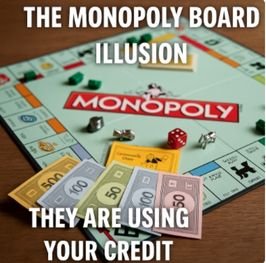Banks use your credit to create “loans” and “mortgages” Now you can recoup your credit, redeem the mortgage in fiat, release the mortgage charge, and then recoup that redemption payment too—quietly, lawfully, and without a war with the mortgage market.
Your signature animated the entry; the bank acted as nominee and later securitised the note.
When you signed, the bank booked your note as its asset and created a matching deposit/liability—the “loan” you think you borrowed.
Download eBook – The banks are using your credit and how to recoup it.
Recoup the face value of mortgages and bank payments.
Most people who try to exit a mortgage go to war: they argue bad signatures, securitisation, fraud, “no consideration,” and then spend months (or years) in litigation. If they stop paying, foreclosure looms—and the bank takes the property anyway.
Recoup the credit that originally created your mortgage.
Redeem the account in fiat so the servicer willingly removes the charge.
Recycle year on year to build financial abundance.
No courtroom fights. No brinkmanship. You’re using the system exactly as it’s designed—so everyone in the chain cooperates.
Peace is best: Recoup → Redeem → Recoup → Repeat.
(Detailed discussion and citations appear in our member guide and webinar.)
Correct the nominee posture and recover the value attributed to your instrument.
Use a portion of the recouped credit to pay off the servicer. They close the account and release the charge at the registry—no drama.
 In 1933, the United States Incorporated declared bankruptcy under House Joint Resolution 192 (H.J.R. 192). This act suspended the requirement for debts to be paid in lawful money (gold and silver), replacing it with credit instruments. From that moment forward, the foundation of the world’s financial system shifted from substance to illusion—gold was removed, and credit, issued on the energy of men and women, became the medium of exchange.
In 1933, the United States Incorporated declared bankruptcy under House Joint Resolution 192 (H.J.R. 192). This act suspended the requirement for debts to be paid in lawful money (gold and silver), replacing it with credit instruments. From that moment forward, the foundation of the world’s financial system shifted from substance to illusion—gold was removed, and credit, issued on the energy of men and women, became the medium of exchange.
Every nation-state today operates as a body corporate, registered like a subsidiary of United States Incorporated, as evidenced in the EDGAR database. The bankruptcy of the U.S. thus cascaded across the entire world: if the parent corporation is bankrupt, so too are all its subsidiaries. The United States Treasury functions as the bankruptcy trustee of this global corporate insolvency, holding administration over the energy and credit of the world’s people.
To understand this system, we turn to the analogy of the Monopoly board. On the board, everything appears real—properties, money, and players—but in fact, it is a simulation. The money circulating on the board is artificial; the properties are tokens. Similarly, in our financial system, all credit is artificial, created through the birth certificate trust accounts and social insurance numbers that securitize the life energy of every man and woman. In 1933, through H.J.R. 192, a mortgage was placed over the energy of the people, ensuring that their labor and consciousness would be harnessed to back the bankrupt system.
This structure was designed with a single objective: to place the average citizen into perpetual debt slavery. The illusion is complete—men and women believe they are debtors when in fact they are the creditors. The true origin of credit is not the banks or governments but the conscious energy of the people themselves.
Here lies the remedy: as a living man or woman, you are the creditor to the system. You are lawfully entitled to recoup what originates from your own energy. Through the Infinite Money Programme, you reclaim your rightful position as creditor, remove yourself from the artificial Monopoly board, and restore credit back to its true source: your living consciousness.



One lawful, IRS-recognized pathway to enforce recoupment is the 1099-OID (Original Issue Discount) process:
To maximize protection and efficiency, the recoupment process is administered through an international Grantor Trust:
The old route tried to prove void/ab initio. The calm route sidesteps the fight: recoup → redeem → recoup, with the same end—a liberated home.
The calm path can still apply. Redeeming the account moots the enforcement; we also provide a court-stage pack for pausing escalation while you complete redemption. (See member area.)
No—education only. We encourage professional advice for filings, trust setup, and local compliance.
Watch the 10‑minute explainer or join our next webinar to see the full member workflow and case studies.
Join the Republic of Old Souls – Get Free Lawful Education and Learn the Exact Steps to Start Your Protocol
Please wait while you are redirected to the ROS platform.